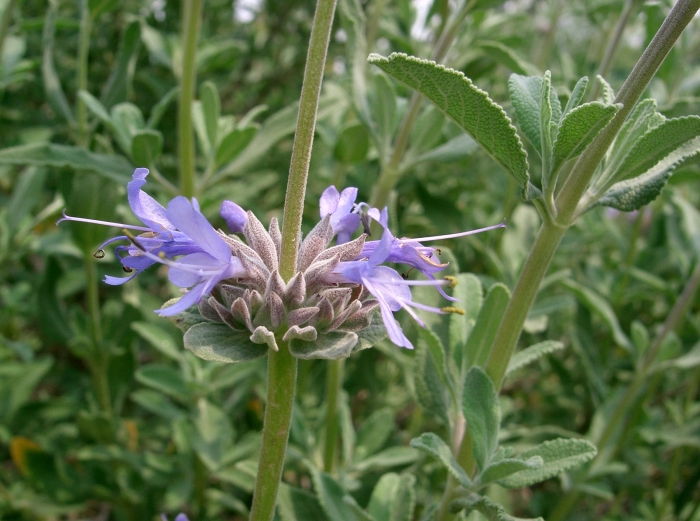Fragrant Sage
(Salvia clevelandii)
Fragrant Sage (Salvia clevelandii)
/
/

KENPEI
CC BY-SA 3.0
Image By:
KENPEI
Recorded By:
Copyright:
CC BY-SA 3.0
Copyright Notice:
Photo by: KENPEI | License Type: CC BY-SA 3.0 | License URL: http://creativecommons.org/licenses/by-sa/3.0/ | Uploader: KENPEI | Publisher: Wikimedia Commons | Title: Salvia_clevelandii2.jpg | Notes: [[Commons:Batch_uploading/AucklandMuseumCCBY|Auckland Museum]] Page 341.43 Object #34142 AK376554 Image 1/2 http://api.aucklandmuseum.com/id/media/v/751534 |















































































Estimated Native Range
Summary
Salvia clevelandii, commonly known as fragrant sage, blue sage, Jim sage, or Cleveland sage, is a perennial evergreen shrub native to the coastal sage scrub and chaparral ecosystems of Southern California and northern Baja California, typically found below 900 meters (3,000 feet) in elevation. This plant is well-adapted to the Mediterranean climate of its native range, with hot, dry summers and mild, wet winters. It reaches 1 to 1.5 meters (3.3 to 4.9 feet) in both height and width, featuring fragrant, ashy green leaves and striking flowers. The blooms are borne on 30-centimeter (12-inch) spikes with numerous whorls of upright amethyst flowers that are particularly showy in June and July.
Salvia clevelandii is valued for its aromatic foliage and vibrant flowers, which attract pollinators such as bees and hummingbirds. It is a popular choice for xeriscaping and native plant gardens in the Southwestern United States, where it has been cultivated since the 1940s. The plant is known for its drought tolerance and is often used in water-wise landscaping. It prefers well-drained soils and can handle full sun, especially in cooler coastal areas, but also grows well in part shade. While it has a relatively short lifespan of five to ten years, it can be propagated easily from cuttings. Salvia clevelandii is hardy to −7 °C (19 °F) and may require protection in colder climates. Potential problems include root rot in poorly drained soils and mildew in humid conditions.CC BY-SA 4.0
Salvia clevelandii is valued for its aromatic foliage and vibrant flowers, which attract pollinators such as bees and hummingbirds. It is a popular choice for xeriscaping and native plant gardens in the Southwestern United States, where it has been cultivated since the 1940s. The plant is known for its drought tolerance and is often used in water-wise landscaping. It prefers well-drained soils and can handle full sun, especially in cooler coastal areas, but also grows well in part shade. While it has a relatively short lifespan of five to ten years, it can be propagated easily from cuttings. Salvia clevelandii is hardy to −7 °C (19 °F) and may require protection in colder climates. Potential problems include root rot in poorly drained soils and mildew in humid conditions.CC BY-SA 4.0
Plant Description
- Plant Type: Shrub
- Height: 3-4.5 feet
- Width: 3-4.5 feet
- Growth Rate: Moderate
- Flower Color: Purple
- Flowering Season: Spring, Summer
- Leaf Retention: Semi-deciduous
Growth Requirements
- Sun: Full Sun, Part Shade
- Water: Low
- Drainage: Fast, Medium
Common Uses
Bee Garden, Bird Garden, Border Plant, Butterfly Garden, Deer Resistant, Drought Tolerant, Fragrant, Hummingbird Garden, Low Maintenance, Rabbit Resistant, Rock Garden, Showy Flowers, Street Planting
Natural Habitat
Coastal sage scrub and chaparral ecosystems
Other Names
Common Names: Blue Sage , Jim Sage , Fragrant Sage
Scientific Names: Salvia clevelandii , Audibertia clevelandii , Salvia cleavelandii , Audibertiella clevelandii , Ramona clevelandii
GBIF Accepted Name: Salvia clevelandii (A.Gray) Greene